Ball Martin, M?ller Nicole. The Celtic Languages
Подождите немного. Документ загружается.

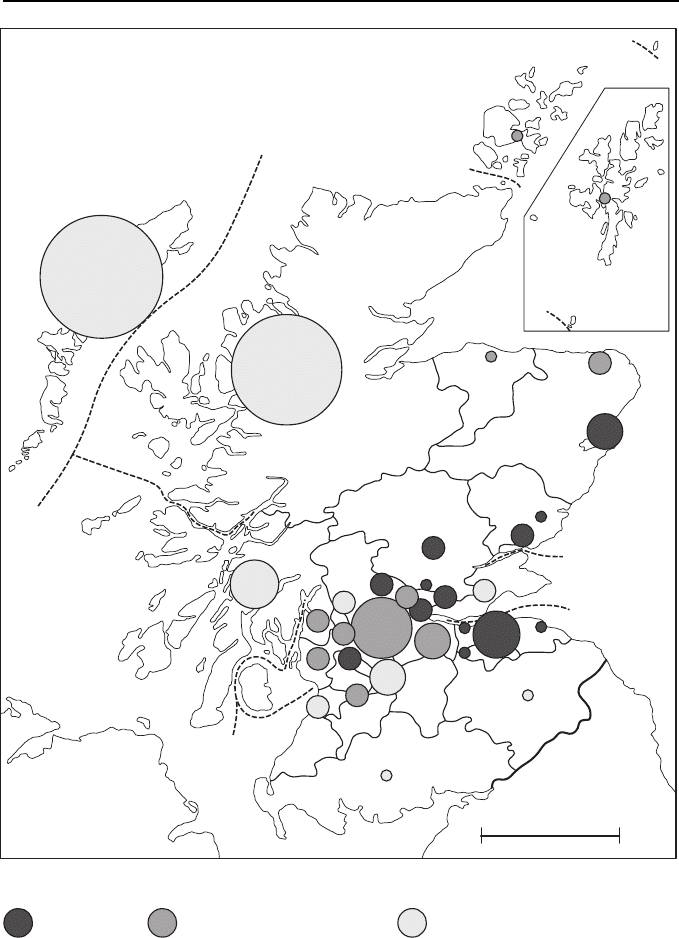
596 THE SOCIOLINGUISTICS OF THE CELTIC LANGUAGES
Falkirk
East
Ayrshire
South
Lanarkshire
North
Ayrshire
Midlothian
West
Lothian
Fife
East
Lothian
City of
Edinburgh
Argyll
and Bute
City of
Aberdeen
Numbered areas
1 West Dunbartonshire
2 East Dunbartonshire
3 North Lanarkshire
4 Glasgow City
5 East Renfrewshire
6 Renfrewshire
7 Inverclyde
8 Clackmannanshire
Orkney
Islands
Shetland
Islands
Increase Decrease less than 88.9% Decrease greater than 88.9%
Size and location of Gaelic populations and intercensal change: 2001 census Scotland
Council areas
Western
Isles
Highland
Moray
Aberdeenshire
Perth and
Kinross
Angus
Scottish
Borders
Dumfries and
Galloway
Stirling
South
Ayrshire
50 miles
80 km
Figure 13.6 Map 2001 census – council areas. Source: base map supplied by General
Register Offi ce (Scotland), data from 2001 census plotted by K. MacKinnon 2008

SCOTTISH GAELIC TODAY 597
DOMAINS OF USAGE: GAELIC IN THE COMMUNITY
Gaelic usage is typically diglossic, and its character has been studied in a number of Gaelic
communities. In terminally Gaelic East Sutherland, Dorian (1981b: 112) reported Gaelic
being used in high domains (such as the church), and English in low domains (doubt-
less the family). In a study of a rapidly weakening Gaelic community in Mull (Dervaig),
although not focusing on diglossia itself, Dorian reported on the unfavourable reactions of
non- Gaelic speakers to ‘exclusionary’ use of Gaelic – and of its value to Gaelic speakers
(Dorian 1981a: 176–7).
Diglossic usage of Gaelic and English was examined in studies in Harris in the early
1970s (MacKinnon 1977: 143–57), in Barra and Harris in the late 1970s (MacKinnon and
MacDonald 1980: 91–100; MacKinnon 1985a: 73), and in Skye and the Western Isles
in the late 1980s (MacKinnon 1988a, b). The general pattern emerging from these vari-
ous studies seems to indicate that community usage of Gaelic might often stand up better
than family usage – especially where children’s schoolwork and peer- group and sibling
exchanges are concerned. The religious domain was weakening and might not function
much longer as the bulwark for the language that it once was. In strongly Gaelic commu-
nities Gaelic predominated in most work domains – especially crofting – and in exchanges
with older relations. Local post offi ces and shops could be pivotal domains for commu-
nity usage, and where these had been taken over by non- Gaelic- speaking incomers (as in
southern Skye) Gaelic would rapidly retreat to within the family.
Although the three surveys were not undertaken with identical test instruments, the
questions were suffi ciently similar for some degree of comparison over time and place to
be feasible. The details of the Isle of Harris survey undertaken in 1973 (from MacKinnon
1977: 150–2, 155–6) provide a profi le in some detail of 55 family and community speech
situations, and the extent to which Gaelic or English predominated in the whole sample
of 85 Gaelic- speaking adults and in its younger and older generations (see Table 13.1 and
Figure 13.7, p. 600).
Table 13.1 ‘Demesne- extension’ of Gaelic among Gaelic- speaking adults, Harris 1973
(N = 85). Source: MacKinnon 1977: 150–2, 155–6
Rank
order
Speech activity in which
Gaelic may be used
Members of
sample engaging
in the activity
who claim to use
Gaelic alone
Inter-
generational
language
shift*
Numbers of
individuals
engaging in
the activity
1 To older relations 96.0 2.8 74
2 To parents 95.8 2.6 71
3 To spouse when alone 92.1 25.0 63
4 To older people locally 86.5 19.0 74
5 When on own croft working 84.5 22.4 71
6 For family prayers and
worship
83.8 11.6 80

598 THE SOCIOLINGUISTICS OF THE CELTIC LANGUAGES
7 When on croft work with
others
79.4 17.8 63
8 To a missionary 78.1 4.2 73
9 To family at home (generally) 78.1 23.4 82**
10 To a church elder 77.8 5.7 72
11 To other members of family
(not spouse or parents)
76.8 22.8 73**
12 For praying to yourself 74.7 19.4 83
13 At township or grazing
meeting
72.2 20.5 54
14 To younger people locally 69.9 21.9 73
15 To younger relations 68.5 18.0 73
16 To minister 68.5 9.5 73
17 At church meetings 68.0 31.3 78
18 For quarrelling or ‘telling- off’
locally
66.7 2.4 75
19 In post offi ce 66.3 10.5 83
20 To shopkeepers or van drivers 66.2 6.6 74
21 For local shopping 65.5 23.0 84
22 To a Gaelic- speaking stranger,
same age and opposite sex
64.3 10.8 70
23 To a Gaelic- speaking stranger,
same age and same sex
63.4 11.2 71
24 For explanations to children 63.0 6.6 73
25 To children (misbehaving) 63.0 12.2 73
26 To fellow- workers at
workplace
62.9 11.5 62**
27 To others at work 62.9 48.1 70**
28 To children about morality 62.9 21.0 70
29 To a foreman at work 62.8 27.3 43
30 To a nurse 59.5 10.4 74
31 When buying petrol 58.6 16.7 58
32 To a schoolteacher 55.6 16.3 72**
33 At a public entertainment 54.7 –1.7 75
34 To the district clerk 54.2 28.0 72

SCOTTISH GAELIC TODAY 599
35 When discussing a child with
teachers
50.0 4.8 70**
36 When dreaming 49.4 21.3 81
37 On public transport 49.4 2.4 81
38 In a club or society meeting 45.9 4.0 66
39 To a workman at your door 45.5 –17.6 66
40 To a local councillor 47.2 9.5 73**
41 For swearing 44.6 8.5 56
42 At a sports or recreation
meeting
43.1 14.6 58
43 For discussing local problem
with a councillor
42.3 –15.6 78**
44 To a shopkeeper you do not
know
42.5 21.5 73
45 When counting to yourself 36.2 16.9 83
46 To a crofting assessor 24.6 2.6 57
47 To waiter in hotel or café 23.2 0.6 69
48 To travelling salesman 22.4 0.9 67
49 To an inspector 17.4 –6.9 69
50 To a telephone operator 16.4 –4.3 73**
51 To a telephone operator on
Harris exchange
15.2 –7.7 79**
52 In the bank 13.8 –2.2 80
53 To a policeman 13.0 –6.7 69
54 To a doctor 10.8 7.3 74
55 In a letter to one of the family 2.5 5.9 81
Mean incidence of use of
Gaelic only
55.6
Mean extent of
intergenerational shift
10.9
Notes
* Intergenerational language shift represents the difference between the percentages of the older (over
60) and younger (under 40) respondents who claimed to use Gaelic only in each situation. Negative
value indicates shift in favour of Gaelic.
** The closeness of results in these cases provides some internal validation of the exercise as the closely
synonymous questions are derived from separately administered questionnaires.

Figure 13.7 Intergenerational language shift: Gaelic- speaking adults Harris 1973. The speech situations are numbered in
Table 13.1. Source: MacKinnon (1977: 150–2, 155–6)
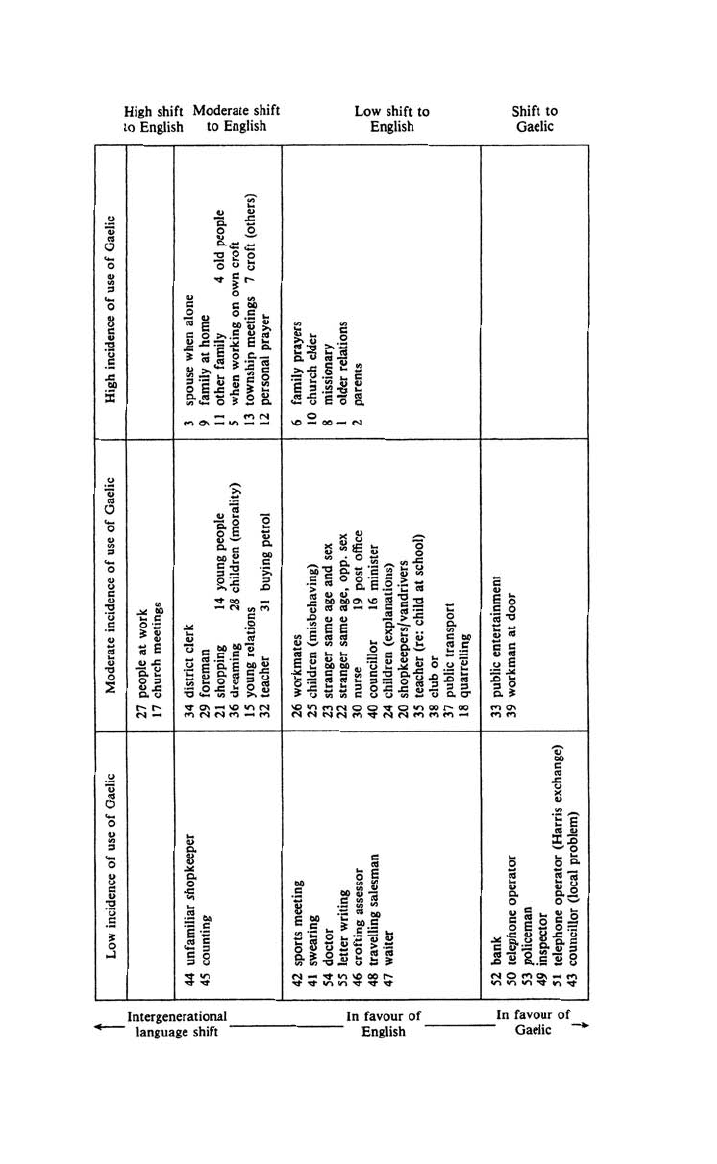
Figure 13.7 (continued)
societysociety

602 THE SOCIOLINGUISTICS OF THE CELTIC LANGUAGES
There is some indication that among the younger (under- 40) generation some of the
diglossic patterning was breaking down, with a shift towards Gaelic in some of the more
modern domains, and in exchanges in public entertainments.
The surveys in Barra and South Harris in 1978 did not cover as many speech situa-
tions, but an attempt was made to elicit details regarding language usage in respondents’
families of origin. Thus a more diachronous impression of intergenerational language
shift could be derived. The details are illustrated in Figures 13.8 on pp. 603–4 and 13.9 on
pp. 605–6.
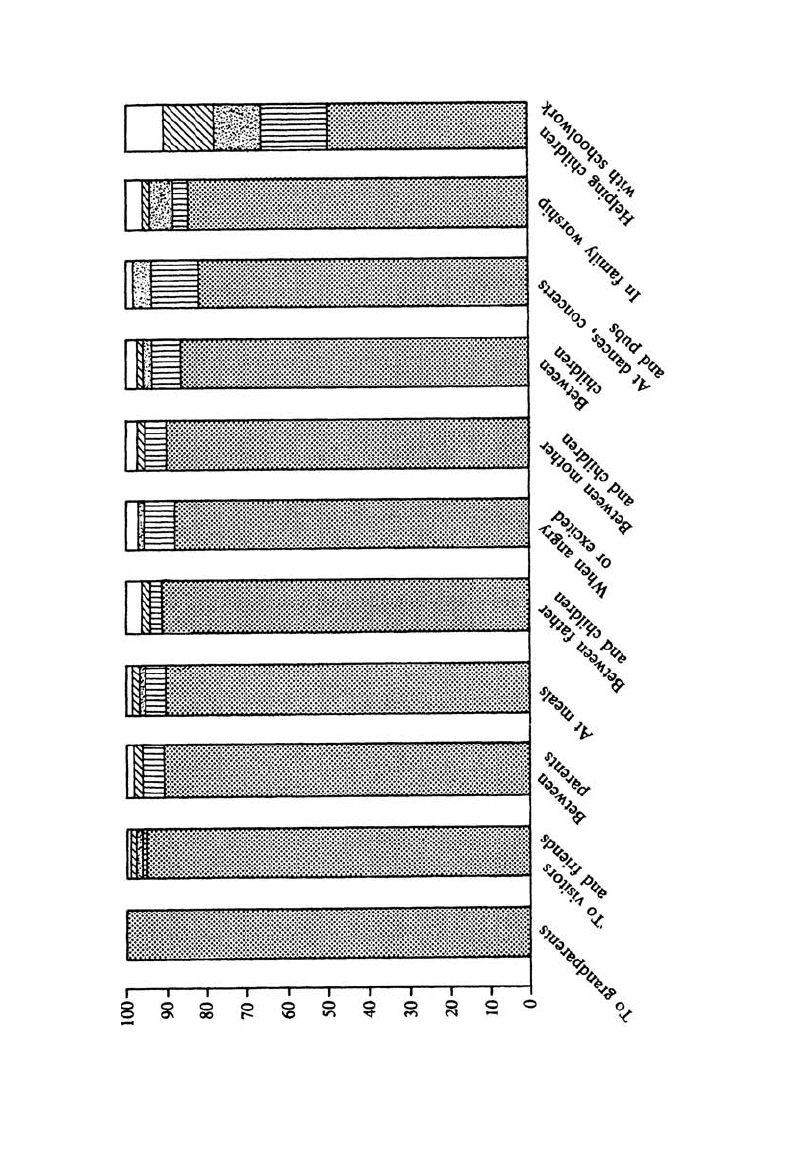
Figure 13.8a Western Isles (Barra) 1978 survey – Gaelic usage in family of origin. Source: MacKinnon and MacDonald,
Appendix: 2–4
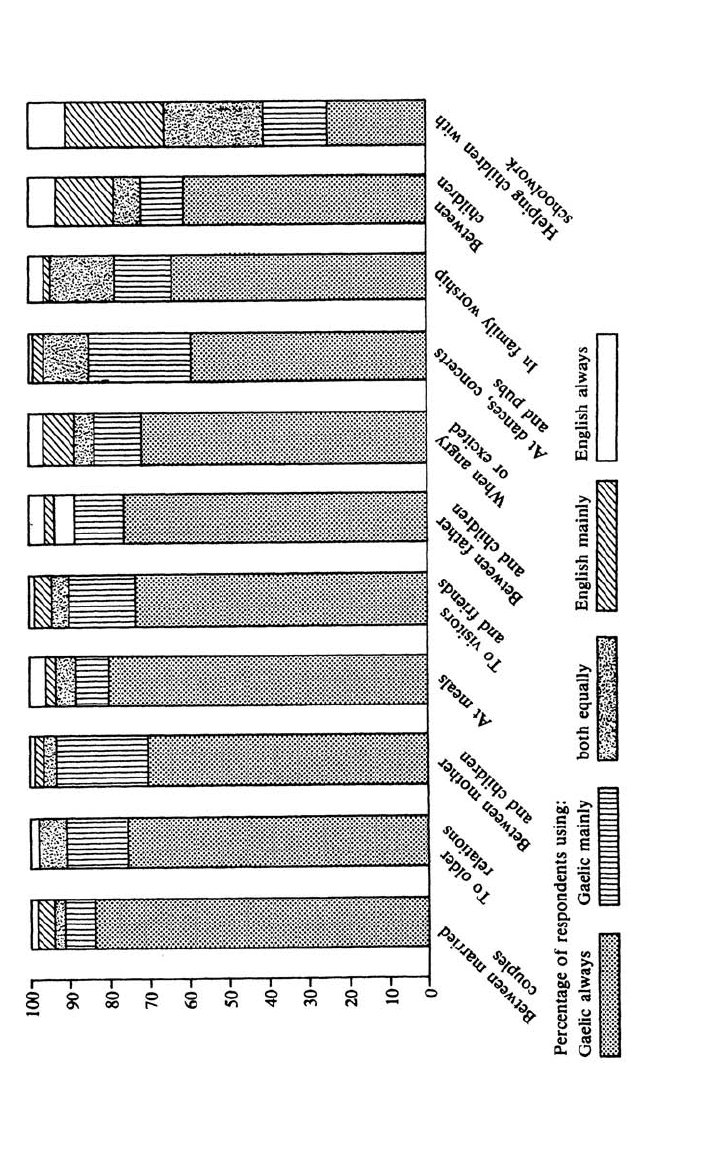
Figure 13.8b Western Isles (Barra), 1978 survey – Gaelic usage in present- day family. Source: MacKinnon and MacDonald,
Appendix: 2–4
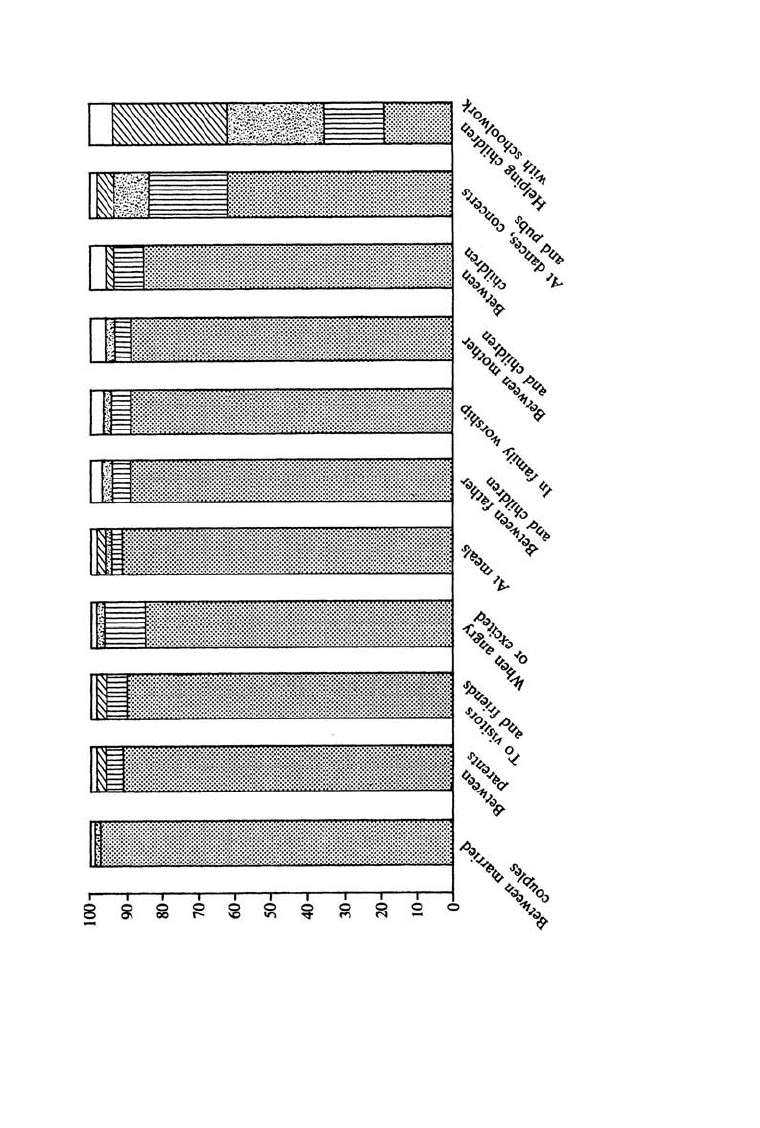
Figure 13.9a Western Isles (Harris), 1978 survey Gaelic usage in family of origin. Source: MacKinnon and
MacDonald, Appendix: 2–4
